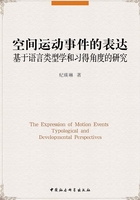
2.2.1 Universal determinants in children's acquisition of spatial language
In the last thirty years, a large group of linguists and psycholinguists have maintained the claim that the acquisition of spatial terms and relations can be characterized by a relatively direct process of mapping grammatical forms onto concepts of space that have been formulated independently of language.It is no wonder that this idea has been firmly held until quite recently, as Bowerman (1999) explains:
If any domain has a plausible claim to strong language-independent perceptual and cognitive organization, it is space.The ability to perceive and interpret spatial relationships is clearly fundamental to human activity, and it is supported by vision and other highly structured biological systems...Our mental representations of space are constrained not only by our biology but also by their fit to the world “out there”: if we try to set an object down in midair, it falls, and if we misrepresent the location of something, we cannot find it later.Little wonder it has seemed likely to many investigators that the language of space closely mirrors the contours of nonlinguistic spatial understanding (ibid.: 387).
The assumption that children first cognitively develop basic spatial concepts and then acquire spatial terms and relations by drawing on these privileged notions is first of all related to the traditional philosophical idea of Kant that space is a universal cognitive primitive, and then to the seminal empirical work of Piaget and Inhelder (1956) who found that there is a close correspondence between the sequence in which children construct their spatial knowledge and the order in which they acquire spatial words.Piaget and Inhelder noted that the earliest spatial notions developed are concerned with object containment and support, which are then followed by the concepts of proximity, separation, surrounding and order, all of the latter being topological relations involving no perspective or measurement.It is only at a later stage that children gradually construct a projective space and a Euclidean space involving a system of axes and co-ordinates (Johnston 1988, Bowerman 1999, Bowerman and Choi 2001, Hickmann 2006).
Corresponding to the above sequence of the development of cognitive spatial concepts, it is found that English children learn spatial prepositions in a similar order: words for functional and topological notions like containment, support and occlusion emerge first (e.g.in,on,under); then those reflecting the notion of proximity (e.g.next to,beside,between); and then those for projective spatial relations (e.g. in front of,behind).This developmental progression is attested in the studies of Johnston and Slobin (1979) and Johnston (1988) who report that across the languages of English, Italian, Turkish and Serbo-Croatian various adpositions encoding different spatial relations are acquired according to a certain concept-driven sequence over a long period of development (Allen et al. 2007: 19).These findings suggest that the non-linguistic concepts underlying language may emerge in children in the same order and at about the same rate across all languages, which prompts Slobin's (1985) argument that children start out with a shared pre-structured ‘semantic space’ in which meanings and clusters of meanings constitute ‘primordial building blocks’ onto which functors and grammatical constructions are first mapped.The result of this initial mapping process is a ‘universally specifiable Basic Child Grammar’ (as in a review by Bowerman 1994).
This Piagetian assumption that spatial concepts are a prerequisite for and precede the development of spatial language finds its support in a series of further studies.It has been shown that children already know a great deal about space and spatial relations among objects and motion events long before they learn to talk about them.Habituation studies of infant perception (Antell and Caron 1994, Bomba 1984, Quinn and Eimas 1986, Spelke et al. 1992) reveal that infants can categorize scenes on the basis of spatial information such as above-below, left-right and different orientations of an object; and studies measuring the time spent looking at possible versus impossible events show that infants of only several months old are already able to understand that moving objects must follow a continuous trajectory and cannot pass through one another (Bowerman 1999: 388).Moreover, infants of 7-15 months are able to detect changes in Manner and Path and further categorize events on the Manner or Path basis (Pulverman and Golinkoff 2004, Pruden et al. 2004).
In a similar vein, it is found that children's nonlinguistic understanding of spatial terms always precedes their linguistic knowledge.Levine and Carey (1982) report that even very young children make no mistake in distinguishing the fronts and backs of their toys “well before they can pick up these regions in response to the words of front and back”.This finding echoes E.V.Clark (1973) who observes that children play with objects in ways which strongly suggest that “they understand the concepts of containment and support well before they learn the spatial words of in and on” (Bowerman 1999: 389).Bowerman (1996, 1999) and Bowerman and Choi (2001, 2003) further suggest that conceptual priority in the acquisition of spatial language is also evidenced by children's rapid generalization of newly learned spatial words to a wide range of referent situations that share an abstract spatial similarity (e.g. up for all vertical movement involving an upward direction).Further, the phenomena of underextensions and overextensions in children's use of spatial terms suggest that rather than following the adults’ norm, children rely on their own spatial concepts which have evolved independently of language.
Although literature on universalism differs with regard to the basis of language-independent spatial notions-with some proposing a set of innate and modular knowledge (e.g.Spelke 2003) and others an active and precocious process of perception (e.g.Mandler 1992)-they all use a basic repertoire of privileged cognitive notions to account for the acquisition of spatial terms and spatial relations.The most important implication of the universal approach is that since children regardless of language are comparable in terms of development of their cognitive ability, they should use spatial terms and express spatial relations in a way more similar to each other at a given age level than to adults in their specific native language.